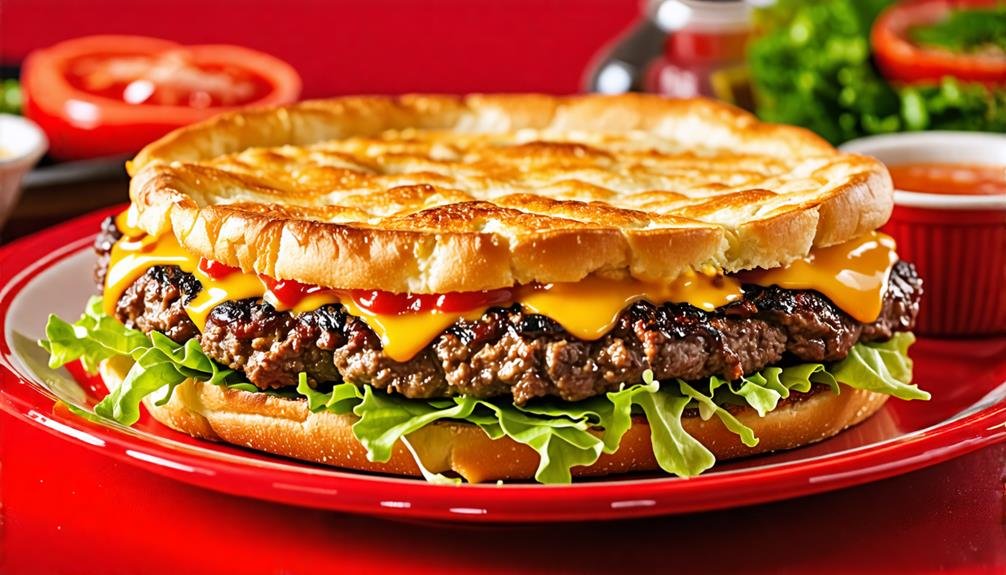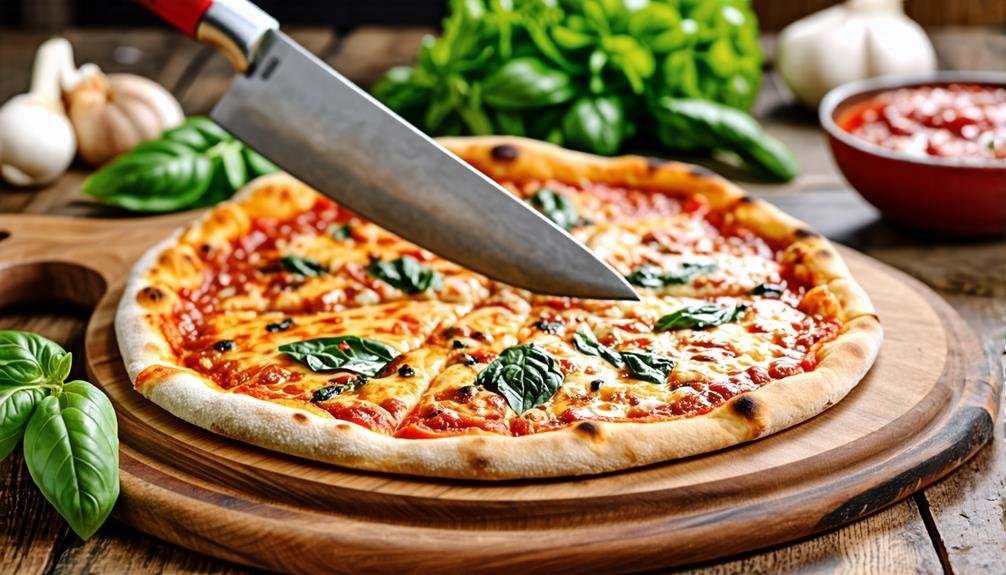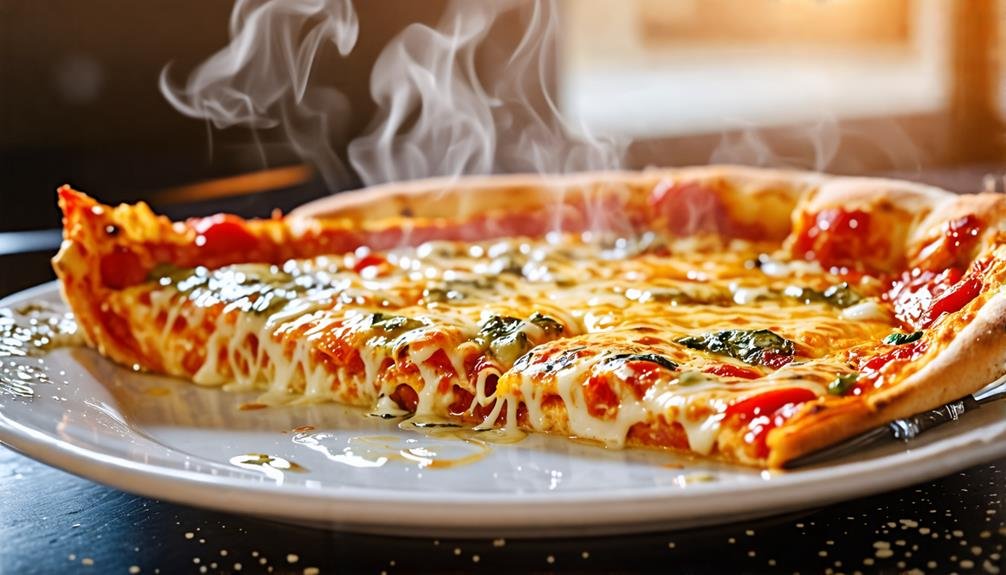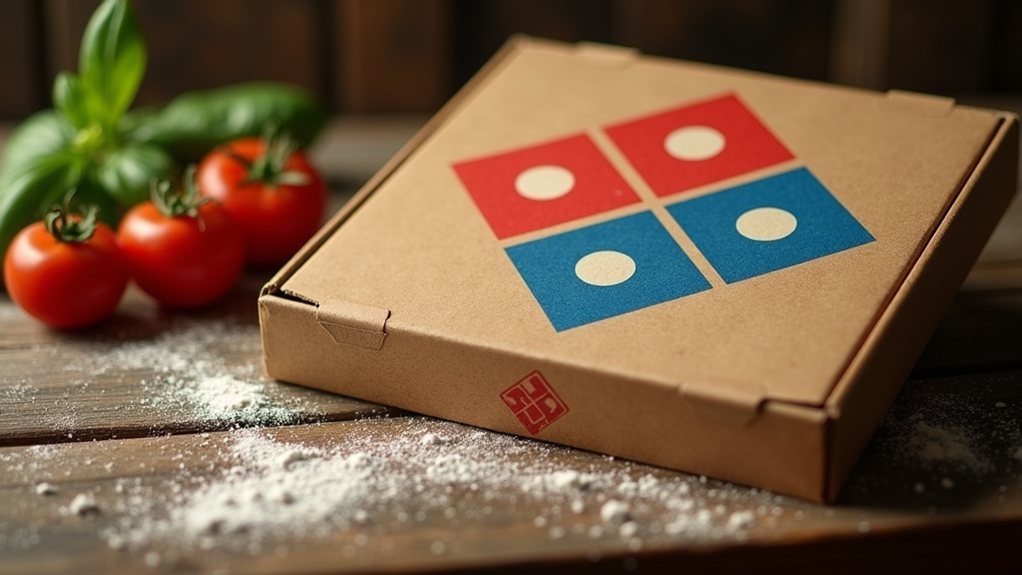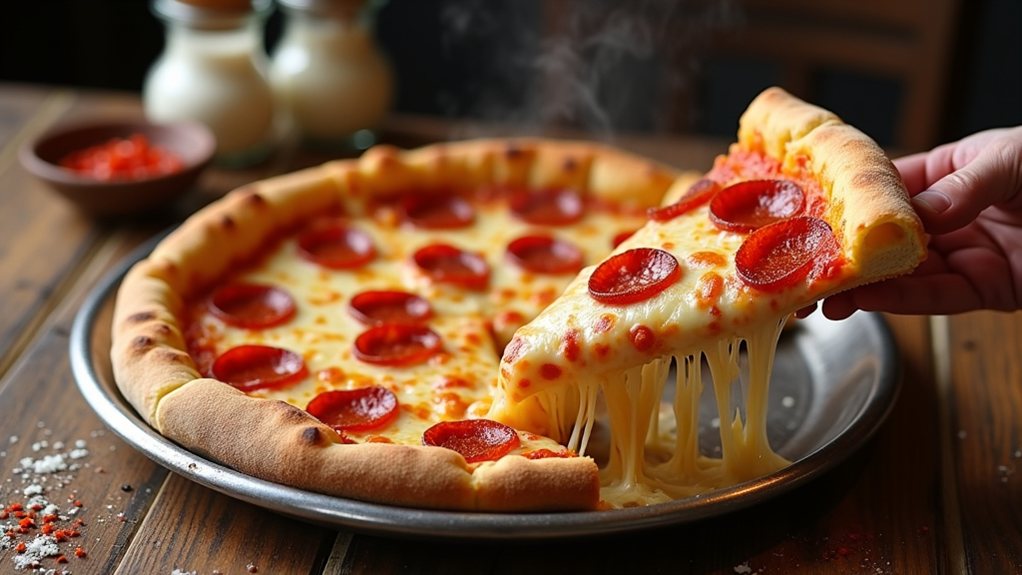A common error in preparing homemade pizza involves mishandling the dough, particularly the inclination to utilize a rolling pin. This approach compresses air pockets, resulting in a denser crust and unsatisfactory texture. Instead, delicately stretch and rotate the dough by hand, which maintains the air pockets necessary for creating a fluffy and light crust. In addition, exercise caution with the quantity of flour used to prevent sticking, but refrain from sprinkling an excessive amount, as it can lead to a dry crust. Grasping these techniques is crucial for enhancing your pizza-making experience, and you may discover further tips for perfecting your homemade pizza.
Stretching Dough by Hand
Stretching pizza dough by hand is essential for creating the perfect texture and airiness in homemade pizza crusts. Many home cooks make the mistake of using a rolling pin, which can harm the dough's structure. Rolling the dough often forces out critical air bubbles, leading to a dense crust instead of the light, airy one desired. Allowing the dough to warm to room temperature improves its flexibility, making it easier to stretch without tearing.
Start by sprinkling flour on your countertop to prevent sticking. Use your fingers to gently press the dough while rotating it in a circular motion, stretching from the edges toward the center. This method ensures uniform thickness and avoids thin spots that can result in uneven baking. Hand-stretching the dough provides better control, helping to preserve the delicate air pockets essential for a flawless crust.
Implementing these pizza-making tips enriches your homemade pizza experience and lets your creativity shine, ensuring that each pizza showcases your unique flavor preferences and style.
Avoiding Soggy Crust
To achieve a perfectly baked pizza without a soggy crust, careful attention to sauce quantity, topping selection, and baking surface is crucial. Using an appropriate amount of sauce prevents excess moisture from saturating the dough, while wisely choosing toppings ensures that the pizza does not become overcrowded, which can trap steam. Moreover, selecting the right baking surface, such as a preheated pizza stone or a rimmed sheet pan, improves heat distribution and contributes to a crispier texture.
Sauce Quantity Matters
The quantity of tomato sauce on homemade pizza plays a critical role in achieving a perfectly baked crust. Excessive moisture can lead to a soggy texture. When applying sauce, consider the consistency and amount carefully. A thin, even layer of sauce is ideal, allowing the crust to receive the necessary heat while preventing dampness.
Overusing sauce can burden the dough, disrupting the even heat distribution required for that desired crispy exterior. While a well-sauced pizza enhances flavor, moderation is key; it should complement the dish rather than overpower it.
The type of sauce is also significant. A thicker marinara sauce, for example, may require even more restraint during application, as its viscosity can trap moisture.
To preserve the crust's integrity, use a ladle or a spoon to spread sauce uniformly across the dough, keeping the edges clear of sauce. This technique helps the crust bake correctly while still delivering a flavorful experience. In summary, the right amount of sauce is vital for crafting a delightful homemade pizza.
Topping Selection Tips
Choosing the right toppings is crucial for avoiding a soggy crust on homemade pizza. When picking toppings, focus on moisture levels; ingredients like fresh tomatoes or moist cheeses can release excess liquid while baking, which can compromise the crust's quality. Instead, opt for drier toppings such as pepperoni, Kalamata olives, or sautéed bell peppers that have had their moisture reduced through cooking. Additionally, layering toppings thoughtfully can help reduce moisture buildup. For example, placing mozzarella cheese directly on the dough forms a barrier, while toppings can be arranged on top to lessen sogginess.
Another important factor is the amount of toppings. Overloading your pizza with ingredients may result in uneven baking and an undesirable texture. Strive for a balanced approach, using a moderate amount of toppings to ensure even heat distribution and proper cooking of each component.
Baking Surface Options
Choosing the right baking surface is crucial for achieving a crisp crust and avoiding sogginess, particularly when dealing with moisture from toppings. A Baking Stone is a fantastic option; it absorbs and retains heat, creating an ideal environment for a perfectly baked crust. Preheating the stone in your Oven allows it to reach optimal temperatures, ensuring that the dough cooks quickly upon contact, which helps to minimize moisture buildup.
Alternatively, a Rimmed Baking Sheet can be a practical substitute. Its raised edges contain any drippings from toppings, while the flat surface promotes even baking. Regardless of the chosen surface, proper preparation is essential. Dust it with Flour or Cornmeal to prevent sticking, which can lead to a soggy base.
Additionally, pay attention to the thickness of your dough and the quantity of sauce used; a thinner base with a moderate amount of sauce can significantly enhance baking performance. Ultimately, the selection of your baking surface, coupled with careful moisture management, will ensure a delightful homemade pizza experience, free from the common issue of a soggy crust.
The Role of Pizza Stones
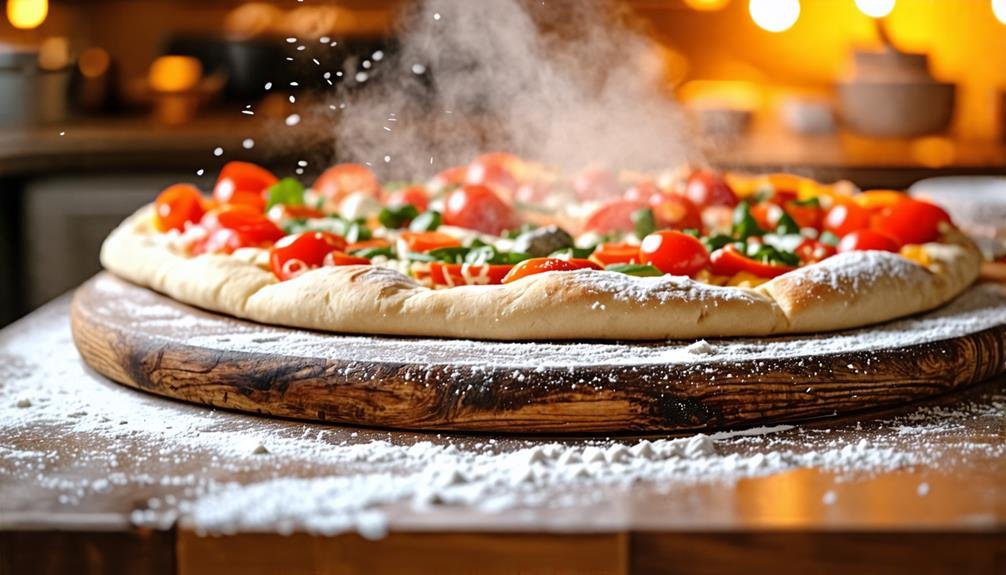
Using a pizza stone, such as the Emile Henry or BakerStone brands, significantly enhances the baking process by providing consistent heat and promoting a perfectly crispy crust. Pizza stones, typically made from materials like ceramic or cordierite, absorb and retain heat, allowing for an even cooking temperature that mimics traditional Italian pizza ovens. When preheated, a pizza stone creates an optimal environment for achieving a golden, crunchy crust—essential for a truly authentic homemade pizza experience.
To maximize the advantages of a pizza stone, it is crucial to preheat it for at least 30 minutes before placing the pizza on its surface. This ensures that the stone is sufficiently heated, which is vital for preventing a soggy bottom. Additionally, a pizza stone helps draw moisture away from the dough, resulting in a drier, crisper crust that is less prone to becoming chewy or tough.
While alternatives like a Nordic Ware rimmed sheet pan can work, they lack the thermal properties that a pizza stone provides. For those who appreciate the freedom to create their ideal pizza, investing in a quality pizza stone is a key step toward achieving restaurant-quality results in the comfort of your own kitchen.
Impact of Rolling Pins
Using a rolling pin often harms the quality of pizza dough. It flattens the dough too much, removing essential air bubbles. This compression results in a tough texture, more like a cracker than the desired soft and chewy crust. Rolling pins are not effective at evenly stretching dough, leading to inconsistent thickness. Some areas may become overcooked, while others remain undercooked.
The pressure from a rolling pin pushes out air bubbles that contribute to a light and airy crust. This loss of air prevents the dough from rising properly during baking, reducing the pizza's overall quality. Furthermore, the aggressive flattening can cause tears in the dough, necessitating more kneading and handling, which disrupts the fermentation process that develops flavor.
Handling Dough Correctly

Proper handling of pizza dough is essential for keeping its air pockets, which help create a light and airy crust. When preparing dough, allow it to warm to room temperature; this enhances its flexibility. Cold dough can be challenging to stretch and may tear. To prevent sticking, sprinkle flour on your countertop before placing the dough.
When stretching the dough, refrain from using a rolling pin, as it compresses the air bubbles and can create a dense crust. Instead, use your hands to gently press and rotate the dough in a circular motion. Start from the edges and gradually move inward, ensuring even thickness throughout. This technique preserves air pockets and results in a more consistent crust.
Be cautious with the tension in the dough; excessive force can cause tearing. By handling the dough delicately, you maintain its structure, leading to a crisp exterior and a tender, flavorful interior. Perfecting the art of dough handling is a crucial step in creating the ideal homemade pizza, whether using brands like Caputo flour or fresh ingredients from your local market.
Maintaining Air Bubbles
Maintaining air bubbles in pizza dough is essential for achieving a desirable crust texture, as these bubbles contribute to the final product's lightness and chewiness. Gentle stretching techniques, rather than aggressive rolling, help preserve these air pockets, ensuring that the dough rises properly during baking. By understanding the impact of air bubbles on crust quality, home cooks can improve their pizza-making skills and create a more satisfying culinary experience.
Importance of Air Bubbles
Air bubbles are essential for achieving the perfect pizza crust. They create a light and airy structure that contrasts with a crisp exterior. During fermentation, yeast produces carbon dioxide, which forms pockets in the dough. When baked, these air pockets expand, resulting in a crust that is tender on the inside and crunchy on the outside.
Maintaining air bubbles is vital for an exceptional pizza experience. Improper dough handling, such as aggressive rolling or excessive kneading, can compromise these bubbles. Flattened dough lacks the structure to rise effectively in the oven, leading to a denser crust that resembles a cracker rather than the fluffy pizza crust that enthusiasts love.
To preserve these crucial air pockets, gentle handling techniques should be used. Stretching the dough instead of rolling it allows the air bubbles to remain intact while achieving an even thickness. By respecting the natural aeration of the dough, bakers can create homemade pizzas that not only look appealing but also provide the delightful texture that enhances the enjoyment of each slice.
Gentle Stretching Techniques
Gentle stretching techniques are essential for maintaining the fragile air pockets in pizza dough, resulting in a light and airy crust after baking. This approach allows the dough to expand while preserving its integrity, preventing the loss of those vital air bubbles. Proper handling methods are crucial for achieving the ideal texture, as they promote even stretching without excessive pressure.
To effectively stretch your dough, consider these helpful suggestions:
- Let the dough rest: Allowing the pizza dough to reach room temperature enhances its flexibility, making it easier to stretch without risking tears.
- Use your hands: Rather than relying on a rolling pin, gently press and rotate the dough using your hands, ensuring uniform thickness while keeping the air pockets intact.
Impact on Crust Texture
The preservation of air pockets in pizza dough is crucial for creating a light and airy crust that enhances the overall enjoyment of the pizza. When the dough is gently stretched by hand, these air pockets remain intact, resulting in a fluffy texture. In contrast, using a rolling pin compresses the dough excessively, eliminating the air pockets that provide essential structure and lift. This often leads to a crust that resembles a dense cracker rather than the sought-after airy base.
To maintain the air pockets' integrity, careful handling of the dough is essential. Stretching from the outer edges promotes an even thickness while reducing the risk of tearing. Additionally, allowing the dough to rest at room temperature increases its flexibility, making it easier to shape without sacrificing texture.
Furthermore, limiting heavy toppings and wet sauces is crucial, as they can weigh down the crust, resulting in a soggy finish. Ultimately, focusing on preserving air pockets not only enhances the crust's texture but also elevates the entire pizza experience, achieving a delightful balance of crispness and tenderness.
Tips for Perfect Pizza
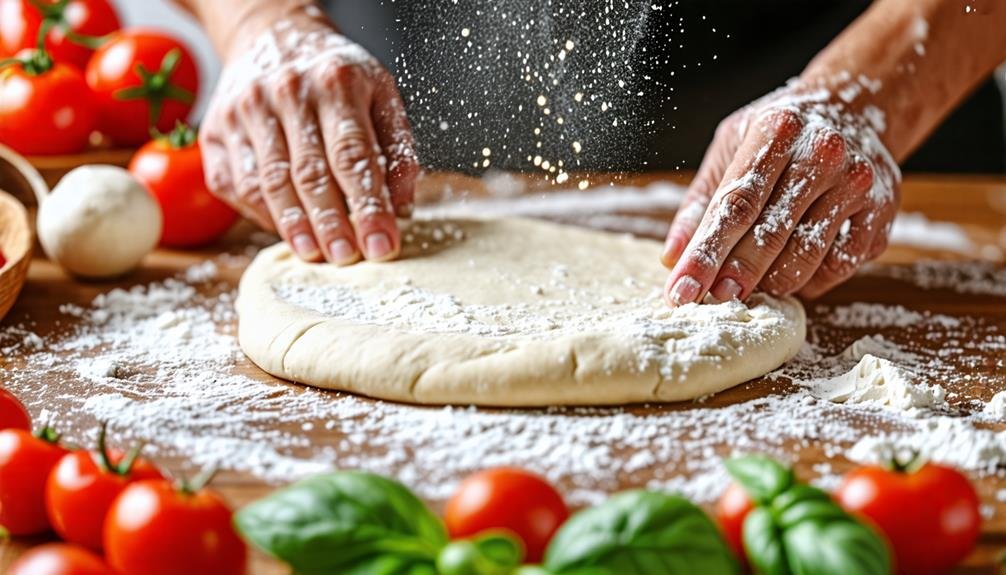
Creating the ultimate homemade pizza demands careful attention to both dough crafting and topping choices. A delicious pizza starts with the dough, which should be hand-stretched to preserve its light, airy quality. Relying on hand-stretching instead of a rolling pin helps maintain the dough's texture and prevents toughness.
For toppings, achieving harmony is essential. Enhance your pizza-making journey with these tips:
- Evenly stretch the dough: Allow gravity to assist you in achieving a consistent thickness, ensuring the crust bakes evenly.
- Control the sauce: Spread a thin layer of tomato sauce to maintain a crisp crust; excessive sauce can weigh down the dough and hinder proper baking.
Common Topping Mistakes
Selecting the ideal toppings is crucial for achieving a delicious homemade pizza. A frequent error is overloading the pizza with ingredients, which can lead to a soggy crust and uneven cooking. Striking a balance is essential; often, fewer toppings enhance the flavor and texture more effectively.
Additionally, one must consider the moisture content in toppings. Fresh produce, such as Roma tomatoes, can release excess moisture during baking, resulting in a wet crust. Pre-cooking or patting dry high-moisture ingredients can help mitigate this problem.
Moreover, incorrect layering of toppings can hinder even cooking. Start with a base of marinara sauce and mozzarella cheese, then carefully add meats like pepperoni and vegetables such as bell peppers to ensure uniform heat distribution.

